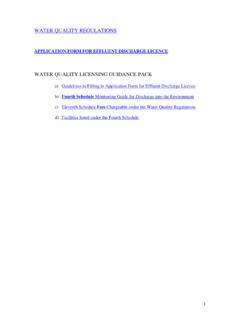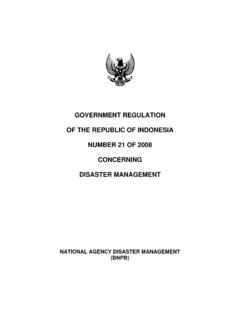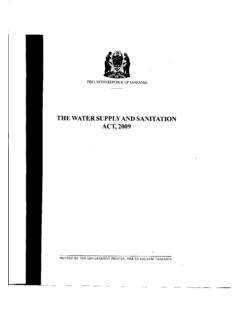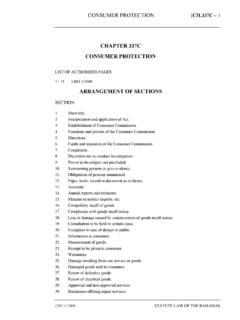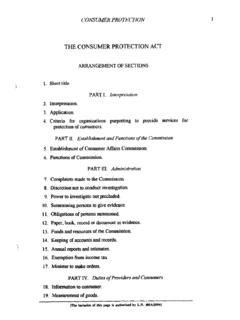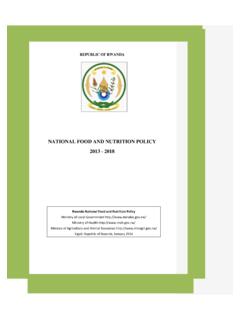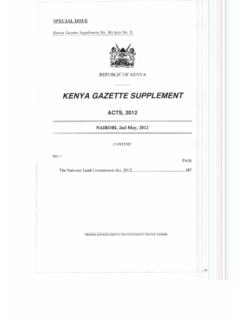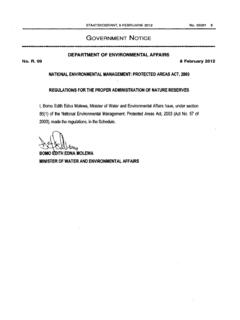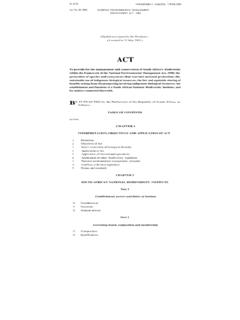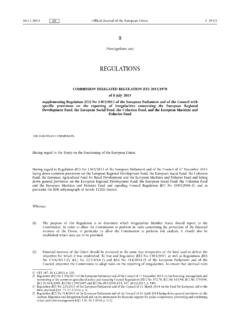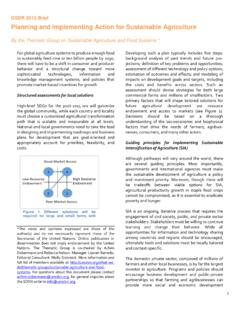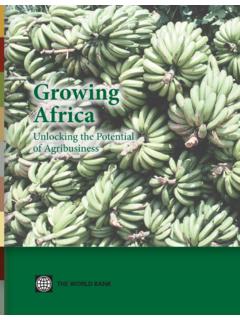Transcription of THE NATIONAL AGRICULTURAL POLICY - Faolex
1 Government of Malawi Ministry of Agriculture and Food Security THE NATIONAL AGRICULTURAL POLICY Promoting AGRICULTURAL productivity for NATIONAL food security and economic growth and development through value chain development Produced by Ministry of Agriculture and Food Security Capital Hill Box 30134 Lilongwe3. July 2010 ii TABLE OF CONTENTS ACRONYMS AND ABBREVIATIONS .. iii FOREWORD .. iv INTRODUCTION .. 1 Importance of agriculture in Malawi .. 1 Evolution of AGRICULTURAL POLICY in Malawi .. 1 Rationale for the POLICY development .. 2 Guiding Principles .. 2 THE NATIONAL AGRICULTURAL POLICY .. 3 Vision .. 3 POLICY Goal .. 3 Mission .. 3 Specific POLICY Objectives.
2 4 AREAS OF THE 4 INPUTS USE AND MARKETS .. 4 Fertilizer .. 4 The seed sector .. 5 Herbicides and fungicides .. 6 Livestock feeds .. 8 AGRICUTURAL PRODUCTION .. 9 Food and Nutrition Security .. 9 AGRICULTURAL Extension .. 11 Land Resources Management .. 12 Crop Production .. 13 CURRENTSITUATION .. 13 Fisheries and Aquaculture Development .. 14 Livestock .. 15 AGRICULTURAL MARKETS DEVELOPMENT .. 16 GENDER, HIV AND AIDS AND AGRICULTURAL DEVELOPMENT .. 17 CLIMATE CHANGE AND ENVIRONMENTAL ISSUES .. 18 BIOFUELS AND AGRICULTURAL DEVELOPMENT .. 19 POLICY Coordination .. 20 Institutional Coordination .. 21 iii ACRONYMS AND ABBREVIATIONS ADD Agriculture Development Division ADP Agriculture Development Programme ADMARC Agriculture Development and Marketing Cooperation AMIS AGRICULTURAL Market Information Systems AU African Union ASWAP Agriculture Sector Wide Approach ALDSAP AGRICULTURAL and Livestock Development Strategy and Action Plan ATCC Agriculture Technology Clearing Committee CAADP Comprehensive African Agriculture Development Programme GDP Gross Domestic Produce GMO Genetically Modified Organisms IDEA Initiative for Development and Equity in African Agriculture US$ United States Dollar SAPs Structural Adjustments Programme MACE Malawi Agriculture Commodity Exchange MASIP Malawi AGRICULTURAL Sector Investment Programme MGDS Malawi Growth and Development Strategy NAP NATIONAL Agriculture POLICY NEPAD
3 New Partnership for Africa s Development NGO Non Governmental Organization PVP Plant Variety Protection UPOV International Union for the Protection of New Varieties of Plants CGIARs Consultative Group on International Agriculture Research Centers iv FOREWORD The NATIONAL AGRICULTURAL POLICY seeks to raise the profile of the AGRICULTURAL sector so that it effectively contributes to the NATIONAL development aspirations of turning the country from a predominantly consuming to a producing and exporting nation targeting all value chain stages. The NATIONAL Agriculture POLICY builds on the various POLICY statements in the sector to give guiding principles to improve agriculture productivity in the wake of various NATIONAL , regional and global opportunities and challenges.
4 The vision of the NATIONAL Agriculture POLICY is to have a nation that enjoys food security and sustainable growth and development. The POLICY goal is to contribute to the attainment of NATIONAL food security, poverty reduction and NATIONAL economic development as outlined in the Malawi Growth and Development Strategy (MGDS). The Ministry of Agriculture and Food Security realizes that to attain this goal in the country requires concerted effort by all players in the sector with a common vision. The NATIONAL Agriculture POLICY will act as a guiding principle to all players as we move together in achieving the MGDS and Millennium Development Goals (MDGs) in the short, medium and long term. The Ministry appeals to all stakeholders to work together in Agriculture sector as it is the backbone of Malawi s economy.
5 The Government endeavors to use resources in the budget in the implementation of this POLICY within the Agriculture Sector Wide Approach (ASWAP) framework which is now taking the programme approach to implement all its activities and pulling resources together. Andrew T. Daudi, PhD Secretary for Agriculture and Food Security July 2010 1 INTRODUCTION Importance of agriculture in Malawi Since independence in 1964, the AGRICULTURAL sector has remained the mainstay of Malawi s economy as it accounts between 36 and 39 percent of the GDP, employs about 80 percent of the workforce, accounts for over 80 percent of foreign exchange earnings, and contributes significantly to NATIONAL and household food security. The AGRICULTURAL sector has two main sub-sectors - the smallholder sub-sector contributing more than 70 percent and the estate sub-sector that contributes less than 30 percent to AGRICULTURAL GDP.
6 Smallholders cultivate mainly food crops such as maize, the main staple grain, cassava and sweet potatoes to meet subsistence requirements, while the estate sector focuses on high value cash crops for export such as tobacco, tea, sugar, coffee and macadamia. Smallholder farmers cultivate small and fragmented land holdings under customary land tenure with yields lower than in the estate sector. In Malawi, the total area under cultivation is estimated at million hectares, of which more than 90 percent is in small farms. It is estimated that the potential AGRICULTURAL land is about million hectares suitable for rainfed, dimba, or wetland cultivation, irrigated land, and plantations plus million hectares of grassland. This means that about half of Malawi s land area can be cropped, of which only about half is currently under crops.
7 Development resources, strategies and policies in Malawi since independence have been heavily biased towards AGRICULTURAL development. While the country has gone through different periods of viable AGRICULTURAL sector accompanied by food insecurity, recently the sector has had impressive growth trends which need to be supported with right POLICY and institutional environment. AGRICULTURAL exports have remained undiversified, with little value addition. About 40 percent of the population live below the NATIONAL poverty line (MK44 or UD$ per person per day) with percent barely surviving. Socio-economic indicators illustrate the depth and intractability of poverty. For example, the levels of malnutrition remain high with per cent of under-five children stunted and 22 per cent underweight.
8 The country s macroeconomic performance has been strong for the past three years due to sound economic policies pursued by the government and good performance in the AGRICULTURAL sector. Malawi has registered a real GDP average growth of percent and average inflation rate of below percent for the past five years. Evolution of AGRICULTURAL POLICY in Malawi Malawi s post independence AGRICULTURAL strategy has been characterized by a dual POLICY of attainment of NATIONAL food self sufficiency through enhancement of the smallholder agriculture and rapid economic growth through estate production with almost all major AGRICULTURAL programmes, strategies and action plans being guided by the food security POLICY . From the mid 1980s, the Malawi Government reviewed its role from that of being both a POLICY formulator and implementer to that of POLICY regulator under the Structural Adjustment Programmes (SAPs).
9 Through this, all restrictions on production of some commodities like burley tobacco by smallholder farmers were removed to accord them with opportunities to enhance their incomes. The other important POLICY reforms are the removal of AGRICULTURAL input and output marketing controls, price decontrols, and the commercialization of parastatals, amongst others. In 1995, the government developed the Agriculture and Livestock Development Strategy and Action Plan (ALDSAP) to provide a framework for coordinating the implementation 2 of various POLICY initiatives. Much as the ALDSAP sought to outline the aspirations for the attainment of the sector s objectives, its implementation registered little success because, amongst other reasons, the sector s policies and strategies were numerous and often overlapping.
10 In 1999, the government undertook a comprehensive review of all AGRICULTURAL sector policies under the Malawi AGRICULTURAL Sector Investment Programme (MASIP). Unfortunately, the review never translated into a coherent POLICY . Meanwhile, the sector has several sub-sector POLICY documents. These policies include the Land Resource Conservation POLICY , the New Agriculture Extension POLICY , the Research Master Plan, the HIV and AIDS POLICY for the AGRICULTURAL sector, the Livestock Development POLICY and the irrigation POLICY , amongst others. In addition, the prevailing socioeconomic environment poses several challenges that need thorough considerations to achieve sustainable growth and development of the AGRICULTURAL sector. In the face of these challenges, the Ministry, through the facilitation of MASIP developed the AGRICULTURAL Development Program (ADP) in 2006.
